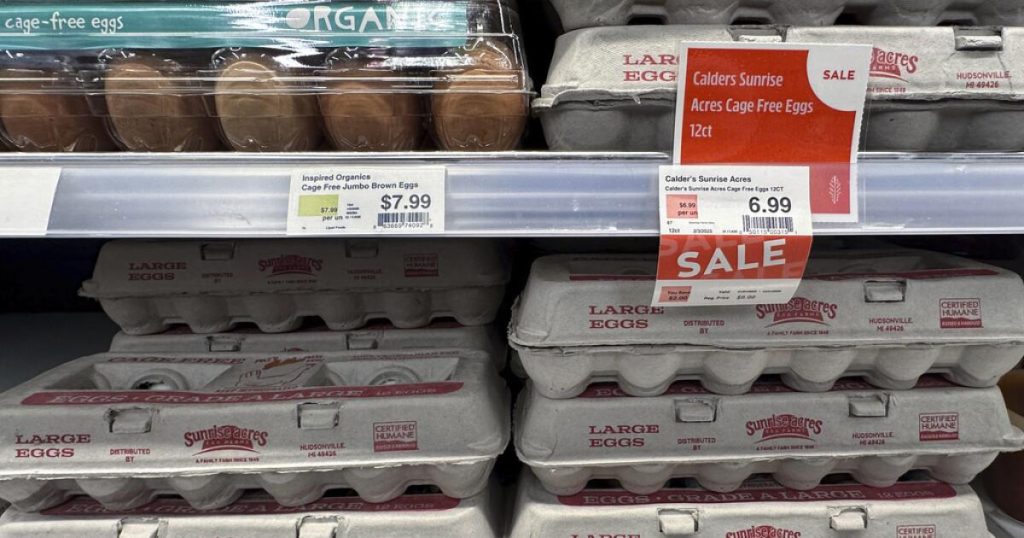The Egg Crisis: How Avian Flu is Impacting Availability and Costs
The current avian flu outbreak has caused a significant disruption in the egg supply chain, making eggs both expensive and difficult to find. The situation has become so dire that some consumers are facing limits on the number of eggs they can purchase. This crisis stems from the ongoing spread of the virus, which continues to mutate and infect millions of birds, as well as some animals and humans. Every time a chicken or turkey flock is infected, the entire flock is culled to prevent further spread, leading to a sharp decline in egg production. While the egg shortage is often localized, the unpredictability of the virus means that large-scale farms with millions of birds could be affected at any time, exacerbating supply chain issues and driving up prices.
The Rising Cost of Eggs
The price of eggs has skyrocketed, with national averages reaching $4.15 per dozen in December alone. This represents more than double the price seen during the summer of 2023, and experts warn that prices could increase by another 20% in the coming year. This surge is particularly challenging for small businesses, such as bakeries and restaurants, that rely heavily on eggs as a key ingredient. Jose Castillo, co-owner of Norma’s Sweets in New Orleans, expressed frustration over the situation, stating that the cost of eggs has nearly quadrupled for his bakery, jumping from $35 to $40 per carton to a staggering $118 to $120 per carton. “Oh, it’s hurting,” Castillo remarked, “It’s crazy how expensive eggs are right now.”
The Hunt for Affordable Eggs
As the egg shortage continues, empty shelves in grocery stores have become a common sight across the country. Many consumers are finding themselves visiting two or three stores—or even turning to local farmers—to secure a carton of eggs. This outbreak has had a devastating impact on the poultry industry since it began in 2022, with nearly 158 million birds culled so far, the majority of which were laying hens. While the industry is generally equipped to handle the loss of a few million birds without significant disruption, the recent wave of infections has led to the culling of more than 23 million birds in just one month. Such large-scale eliminations create a ripple effect, as farmers must disinfect their facilities and wait up to two months before restocking, making recovery a slow and challenging process.
Stores Imposing Purchase Limits
To manage the demands of this strained supply chain, some retailers have introduced limits on egg purchases. Trader Joe’s, for instance, has imposed a nationwide limit of one carton per customer per day in hopes of ensuring that as many customers as possible can access this essential item. Other chains, such as Costco, Whole Foods, Kroger, and Aldi, have also reported varying restrictions, though these are not necessarily uniform across all locations. While Kroger and Walmart have not implemented nationwide limits, some regional divisions have asked customers to limit their purchases to two dozen eggs per visit. Walmart, for example, has limited bulk purchases of 60-count egg cartons to two per transaction. Despite these measures, the company acknowledges that supply remains extremely limited and is working closely with suppliers to meet customer demand while keeping prices as low as possible.
The Economic Burden on Consumers and Businesses
The financial strain of rising egg prices is being felt across the board. For many households, the added expense is straining budgets, particularly for those who rely on eggs as a staple. The situation is even more challenging for businesses, especially those in the food industry. Waffle House, for example, recently announced an additional 50-cent charge per egg on its menu items due to the heightened costs. The demand for eggs is expected to increase further as Easter approaches, a holiday where eggs are both a popular food item and a key part of cultural traditions like Easter egg hunts. As a result, the Bureau of Labor Statistics is likely to report even higher egg prices in the coming weeks, though experts note that these prices may still fall short of the historical high of $4.82 per dozen recorded in January 2023. In some parts of the country, however, consumers are already paying upwards of $10 per dozen for specialty eggs, such as organic or free-range options.
The Rise of Egg Theft
As prices continue to soar, egg theft has emerged as an unexpected consequence of the crisis. In Seattle, police reported the theft of over 500 eggs from a local restaurant, along with other valuable items like bacon and ground beef. In another incident, 100,000 eggs—valued at approximately $40,000—were stolen from a distribution trailer in Pennsylvania. These crimes underscore just how valuable eggs have become during this shortage, with the stolen goods amounting to thousands of dollars. As the avian flu continues to disrupt the supply chain, it seems that the demand for eggs—and their soaring value—will only intensify in the months to come. While there is hope that the situation will eventually stabilize, the current challenges highlight the vulnerabilities of the food system and the far-reaching consequences of a single health crisis.
